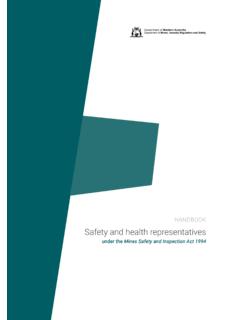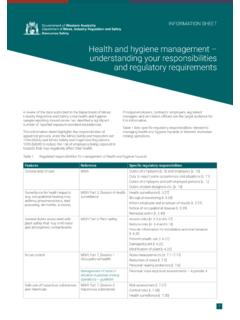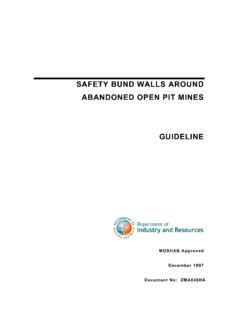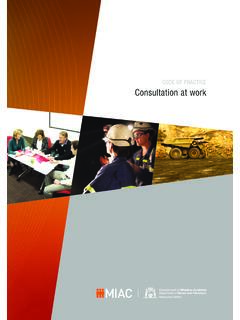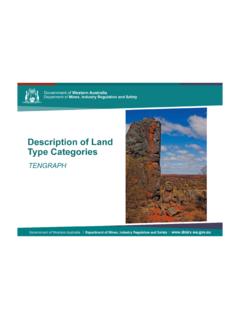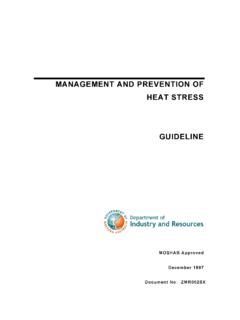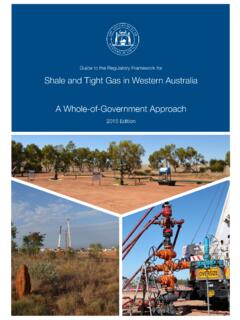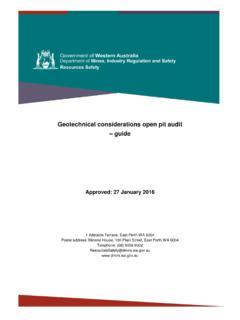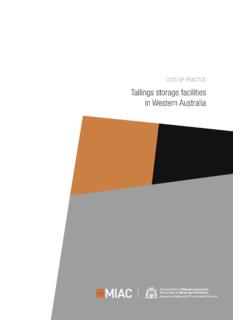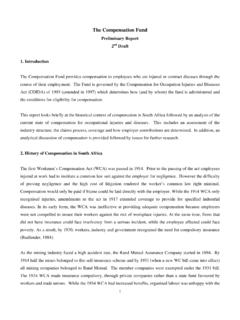Transcription of Reporting dangerous goods incidents - Department of Mines ...
1 Reporting dangerous goods incidents . Guideline (6th edition). Reference The recommended reference for this publication is: Department of Mines and Petroleum, 2011, Reporting dangerous goods incidents guideline (6th edition): Resources safety , Department of Mines and Petroleum, Western Australia, 8 pp. First published in 2008 by the then- Department of Consumer and Employment Protection. Second edition 2009. Third and fourth editions 2010. Fifth and sixth editions 2011. Department of Mines and Petroleum, 2011. ISBN 978 1 921163 76 0 (paperback). 978 1 921163 77 7 (web). Except where the Copyright Act otherwise allows, reproduction in whole or in part of this publication will be permitted only with the prior written permission of the Department of Mines and Petroleum.
2 Requests to reproduce published material should be addressed to the Communications Manager, Resources safety , using the online form. This publication is available on request for people with special needs. This publication is also available in digital format (PDF) online at Further details of publications produced by Resources safety can be obtained by contacting: Resources safety Department of Mines and Petroleum 100 Plain Street EAST PERTH WA 6004. Telephone: +61 8 9358 8002 (general queries). +61 8 9358 8154 (publication orders). NRS 13 36 77. Facsimile: +61 8 9358 8000. Email: (general queries). (publication orders). Disclaimer The information contained in this publication is provided in good faith and believed to be reliable and accurate at the time of publication.
3 However, the information is provided on the basis that the reader will be solely responsible for assessing the information and its veracity and usefulness. The State shall in no way be liable, in negligence or howsoever, for any loss sustained or incurred by anyone relying on the information, even if such information is or turns out to be wrong, incomplete, out-of-date or misleading. In this disclaimer: State means the State of Western Australia and includes every Minister, agent, agency, Department , statutory body corporate and instrumentality thereof and each employee or agent of any of them. Information includes information, data, representations, advice, statements and opinions, expressly or implied set out in this publication.
4 Loss includes loss, damage, liability, cost, expense, illness and injury (including death). Reporting dangerous goods incidents guideline Page ii Foreword The dangerous goods safety Act 2004 (the Act) provides for the safe management of dangerous goods in Western Australia and is supported by the following dangerous goods safety Regulations 2007: Storage and handling of non-explosives Major hazard facilities Road and rail transport of non-explosives Explosives Security risk substances goods in ports General. Section 9 of the Act requires certain dangerous goods incidents , called reportable situations , to be reported. This document provides guidance on reportable situations as required by the Act and applicable regulations.
5 Reporting dangerous goods incidents guideline Page iii Contents FOREWORD .. iii 1 1. 2 Reporting PROCEDURE .. 1. Notification .. 1. Written report within 21 days .. 2. Additional information .. 2. 3 REPORTABLE 2. APPENDIX 1 LEGISLATIVE PROVISIONS .. 5. APPENDIX 2 DEFINITIONS .. 6. APPENDIX 3 REPORTABLE QUANTITIES OF dangerous goods LOSSES .. 7. Reporting dangerous goods incidents guideline Page iv 1 Introduction Section 9 of the dangerous goods safety Act 2004 states that any person who, to any extent, has the control or management of the dangerous goods involved in an incident must as soon as reasonably practicable report the incident to a dangerous goods Officer. Reporting dangerous goods incidents is important as it assists in the prevention of incidents through raising awareness of accident trends and publicising the learnings from investigations.
6 The information presented in this guideline is intended to assist all parties involved with dangerous goods to understand their Reporting duties for dangerous goods incidents . These duties include Reporting timeframes, the requirements for a written report (a form that details what is to be reported) and what incidents must be reported. The Security Risk Substances (SRS) Regulations contain specific Reporting requirements for loss of SRS. While these Reporting requirements do not rely on section 9 of the Act, they are included in this guideline for completeness. The legislative requirements that relate to incident Reporting are listed in Appendix 1. Appendix 2 defines some of the terms used in this guideline.
7 Appendix 3 provides guidance on Reporting losses of specific dangerous goods classes. 2 Reporting procedure Notification The person responsible for the dangerous goods involved in a reportable situation (see Chapter 3) must report the incident to a dangerous goods officer at Resources safety as soon as reasonably practicable ( after emergency response actions have been completed) (Figure 1). Note: It is an offence under the Act not to report a reportable situation. Initial report by phone Once the incident is controlled, the initial phone report to a dangerous goods officer should include information on: nature of incident , including measures to bring the situation under control and whether they were successful, and any injuries or harm.
8 Type and amount of dangerous goods , explosives or security risk substances involved;. location of incident ;. time and date of incident ;. contact details (name, company, position, phone numbers and email address) for person Reporting the incident Reporting dangerous goods incidents guideline Page 1. witnesses anyone injured or affected; and dangerous goods licence numbers (if applicable). Note: If the incident occurred on a mine site, you may also need to inform the District Inspector of Mines . Contact details Telephone: (08) 9358 8002 ( am to pm, Monday to Friday). Facsimile: (08) 9358 8000. Email: Written report within 21 days Unless otherwise agreed with a dangerous goods officer, submit a dangerous goods incident report to Resources safety within 21 days.
9 A pro forma is available from the Resources safety website at in the forms section. Additional information A dangerous goods Officer may request additional information after the incident has been reported. 3 Reportable situations report any dangerous goods incident where people, property or the environment are harmed. The following incidents must also be reported: any dangerous goods incident or incident that, but for intervening events, could have ( near miss) resulted in unreasonable ( serious) harm to people, environment or property;. any incident that results in a dangerous situation; and any incident identified in specific regulations. Table 1 summarises some reportable incidents and who must report them.
10 The regulations provide more specific instructions. incidents that involve substances not classified as dangerous goods but captured by the Western Australian Hazardous Materials (HAZMAT) Emergency Management Plan are not reportable. Examples of other incidents that are not reportable are given in Table 1. Note: There may be Reporting requirements under other legislation ( Environmental Protection Act 1986, Health Act 1911). Reporting dangerous goods incidents guideline Page 2. incident . INITIATE EMERGENCY RESPONSE PROCEDURES. As per emergency plan ( evacuate area, advise any other party who may be at risk from the incident , contain the loss, contact emergency services if required, commence clean-up).
